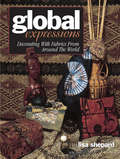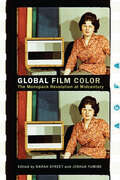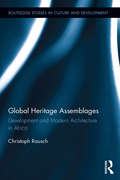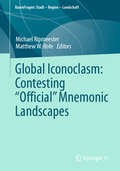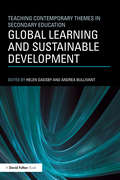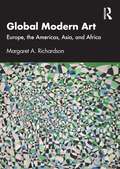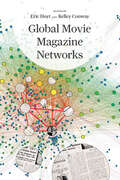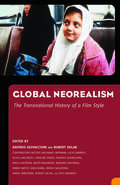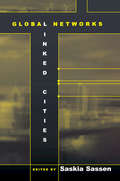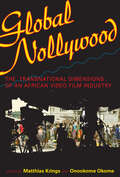- Table View
- List View
Global Convergence Cultures: Transmedia Earth (Routledge Advances in Internationalizing Media Studies)
by William Proctor Matthew FreemanToday’s convergent media industries readily produce stories that span multiple media, telling the tales of superheroes across comics, film and television, inviting audiences to participate in the popular universes across cinema, novels, the Web, and more. This transmedia phenomenon may be a common strategy in Hollywood’s blockbuster fiction factory, tied up with digital marketing and fictional world-building, but transmediality is so much more than global movie franchises. Different cultures around the world are now making new and often far less commercial uses of transmediality, applying this phenomenon to the needs and structures of a nation and re-thinking it in the form of cultural, political and heritage projects. This book offers an exploration of these national and cultural systems of transmediality around the world, showing how national cultures – including politics, people, heritage, traditions, leisure and so on – are informing transmediality in different countries. The book spans four continents and twelve countries, looking across the UK, Spain, Portugal, France, Estonia, USA, Canada, Colombia, Brazil, Japan, India, and Russia.
Global Crisis and the Creative Industries: Analysing the Impact of the Covid-19 Pandemic (Routledge Focus on the Global Creative Economy)
by Ryan DanielWorkers in the creative industries are highly motivated, resilient, and innovative and these characteristics have come to the fore during the global health and resultant economic crises enveloping the world. This shortform book analyses transformation in the arts as a result of this era of polycrisis. The author interrogates public policy, legislative developments, and financial support systems to assist the arts sector around the world. Utilising interview responses from various artis and creatives, the book takes the impact of the Covid-19 pandemic on the global creative industries as its central case study. It looks at the historical relationship between art and times of global crises, the policy initiatives implemented around the world in response to Covid-19 to rescue and support creative industries, explores the ways in which audiences, artists, and creatives responded during the first year of the pandemic, and looks towards future opportunities for the creative industries sector. The book also highlights the importance of higher education for the future creative industries workforce. Providing a concise, yet holistic interpretation of the early impact of the pandemic, the book summarises recent developments, and proposes future directions relevant to students and scholars involved in the creative economy.
Global Design History
by Giorgio Riello Glenn Adamson Sarah TeasleyGlobalism is often discussed using abstract terms, such as ‘networks’ or ‘flows’ and usually in relation to recent history. Global Design History moves us past this limited view of globalism, broadening our sense of this key term in history and theory. Individual chapters focus our attention on objects, and the stories they can tell us about cultural interactions on a global scale. They place these concrete things into contexts, such as trade, empire, mediation, and various forms of design practice. Among the varied topics included are: the global underpinnings of Renaissance material culture the trade of Indian cottons in the eighteenth-century the Japanese tea ceremony as a case of ‘import substitution’ German design in the context of empire handcrafted modernist furniture in Turkey Australian fashions employing ‘ethnic’ motifs an experimental UK-Ghanaian design partnership Chinese social networking websites the international circulation of contemporary architects. Featuring work from leading design historians, each chapter is paired with a ‘response’, designed to expand the discussion and test the methodologies on offer. An extensive bibliography and resource guide will also aid further research, providing students with a user friendly model for approaches to global design. Global Design History will be useful for upper-level undergraduate and postgraduate students, academics and researchers in design history and art history, and related subjects such as anthropology, craft studies and cultural geography.
Global Expressions: Decorating With Fabrics from Around the World
by Lisa ShepardThe fabrics we use to create clothing and home decor reflect our culture and heritage. This book takes readers around the world as it introduces them to fabric techniques through interviews with experts in the field. From sadza batik in Zimbabwe to Japanese sashiko quilting, the authentic method for creating each fabric is explained, along with simplified instructions for recreating the look. Color photographs, patterns, designs and stencils assist readers in utilizing the fabric for unique home decor. Includes an extensive appendix, a detailed glossary and traceable patterns. This book features 12 fabric styles and 15 projects. It offers information on the authentic fabric, how it is created and its place in the culture of the country. Global Expressions presents easy-to-follow directions on how to recreate the fabric.
Global Film Color: The Monopack Revolution at Midcentury
by William Carroll Joshua Yumibe Philip Cavendish Kathryn Millard Sarah Street Laura Major Ranjani Mazumdar Stefan Soloman Kirsty Sinclair Dootson Kamalika Sanyal Heather Heckman Lydia Pappas Elena Gipponi Rafael de Luna Freire Josephine Diecke Linda Chen ZhangGlobal Film Color: The Monopack Revolution at Midcentury explores color filmmaking in a variety of countries and regions including India, China, Japan, and Russia, and across Europe and Africa. Most previous accounts of color film have concentrated on early 20th century color processes and Technicolor. Far less is known about the introduction and application of color technologies in the period from the mid-1940s to the 1980s, when photochemical, “monopack” color stocks came to dominate global film markets. As Eastmancolor, Agfacolor, Fujicolor and other film stocks became broadly available and affordable, national film industries increasingly converted to color, transforming the look and feel of global cinema. Covering a broad range of perspectives, the chapters explore themes such as transnational flows, knowledge exchange and transfer, the cyclical and asymmetrical circulation of technology in a global context, as well as the accompanying transformation of color film aesthetics in the postwar decades.
Global Film Policies: New Perspectives (Routledge Studies in Media and Cultural Industries)
by Ruby Cheung, John Hill, Nobuko Kawashima and Paul McDonaldGlobal Film Policies challenges conventional analyses of film policy as a stand-alone public policy confined within national boundaries and usually focused on supports for film production. The book argues for a more multi-faceted approach, extending beyond national boundaries and broadening its scope to recognise how other forms of policy pertain to film, including tax, labour, language and education.A team of experts in various areas of film and media studies critically analyse specific areas of film policy and engage with other public policy programmes, related concepts and/or phenomena. Each chapter brings together a general discussion of the conceptual and critical issues at stake, with specific references to particular territorial or historical contexts, institutions and policy initiatives that illuminate the more general issues. Case studies from different continents illustrate how film-related policies work with other public policies to maintain their influence not just on the film sector but also society more generally.This book will be an important resource for scholars and students studying global film policy in the areas of film, media or creative industries and business.
Global Geographies of Post-Socialist Transition: Geographies, societies, policies (Routledge Studies in Human Geography)
by Tassilo HerrschelSince the formal raising of the Iron Curtain, there has been much interest in post-socialism and the process of post-socialist transition. This timely book provides a systematic review and analysis of the process of ‘transition’. Herrschel: explores recent theories, concepts and debates on post-socialism and the notion of transition provides a systematic, topical account of post-socialist transitions around the world, as evidence by social, economic, and political processes examines case studies of post-socialist transition in east and Central Europe, the former Soviet Union, Asia and South-East Asia, and Africa and Latin America brings together theoretical and practical aspects by examining what lessons can be learned from recent experiences. Global Geographies of Post-Socialist Transition provides a truly global comparative account of the meaning and processes of post-socialist transition and will be an invaluable resource for all those interested in this area.
Global Glam and Popular Music: Style and Spectacle from the 1970s to the 2000s (Routledge Studies in Popular Music)
by Henry Johnson Ian ChapmanThis book is the first to explore style and spectacle in glam popular music performance from the 1970s to the present day, and from an international perspective. Focus is given to a number of representative artists, bands, and movements, as well as national, regional, and cultural contexts from around the globe. Approaching glam music performance and style broadly, and using the glam/glitter rock genre of the early 1970s as a foundation for case studies and comparisons, the volume engages with subjects that help in defining the glam phenomenon in its many manifestations and contexts. Glam rock, in its original, term-defining inception, had its birth in the UK in 1970/71, and featured at its forefront acts such as David Bowie, T. Rex, Slade, and Roxy Music. Termed "glitter rock" in the US, stateside artists included Alice Cooper, Suzi Quatro, The New York Dolls, and Kiss. In a global context, glam is represented in many other cultures, where the influences of early glam rock can be seen clearly. In this book, glam exists at the intersections of glam rock and other styles (e.g., punk, metal, disco, goth). Its performers are characterized by their flamboyant and theatrical appearance (clothes, costumes, makeup, hairstyles), they often challenge gender stereotypes and sexuality (androgyny), and they create spectacle in popular music performance, fandom, and fashion. The essays in this collection comprise theoretically-informed contributions that address the diversity of the world’s popular music via artists, bands, and movements, with special attention given to the ways glam has been influential not only as a music genre, but also in fashion, design, and other visual culture.
Global Green Infrastructure: Lessons for successful policy-making, investment and management
by Ian MellOver the last decade research exploring green infrastructure planning has burgeoned. Transferable green infrastructure messages between locations though are less well established and there remains a visible gap between the conceptual understanding of green infrastructure and its application in practice. Drawing together evaluations of green infrastructure policy-making and practice from across the world Global Green Infrastructure illustrates where successful practices can be identified. Examples from major green infrastructure development areas in the UK, Europe and the USA highlight the variety of investment options that can deliver socio-economic benefits. There is also a growing awareness of the added value of landscape planning in the rapidly developing cities of India and China. Reflecting on ten international case studies Global Green Infrastructure highlights the ways that ecology and engineered solutions can deliver successful urban development. Based on in situ research with the growing community of green infrastructure researchers and practitioners Global Green Infrastructure looks at the contradictions, consensus, and expanding evidence base of successful investments. This book also presents an in-depth commentary on the contemporary approaches to investment in urban greening and green infrastructure, and draws on the lessons we have learnt from a decade of experimentation, delivery and reflection.
Global Heritage Assemblages: Development and Modern Architecture in Africa (Routledge Studies in Culture and Development)
by Christoph RauschUNESCO aims to tackle Africa’s under-representation on its World Heritage List by inscribing instances of nineteenth- and twentieth-century modern architecture and urban planning there. But, what is one to make of the utopias of progress and development for which these buildings and sites stand? After all, concern for ‘modern heritage’ invariably—and paradoxically it seems—has to reckon with those utopias as problematic futures of the past, a circumstance complicating intentions to preserve a recent ‘culture’ of modernization on the African continent. This book, a new title in Routledge’s Studies in Culture and Development series, introduces the concept of ‘global heritage assemblages’ to analyse that problem. Based on extensive anthropological fieldwork, it describes how various governmental, intergovernmental, and non-governmental actors engage with colonial and post-colonial built heritage found in Eritrea, Tanzania, Niger, and the Republic of the Congo. Rausch argues that the global heritage assemblages emerging from those examples produce problematizations of the modern’, which ultimately indicate a contemporary need to rescue modernity from its dominant conception as an all-encompassing, epochal, and spatial culture.
Global Ibsen: Performing Multiple Modernities (Routledge Advances in Theatre & Performance Studies)
by Erika Fischer-LichteIbsen’s plays rank among those most frequently performed world-wide, rivaled only by Brecht, Chekhov, Shakespeare, and the Greek tragedies. By the time Ibsen died in 1906, his plays had already conquered the theaters of the Western world. Inviting rapturous praise as well as fierce controversy, they were performed in Europe, North America, and Australia, contributing greatly to the theater, culture, and social life of these continents. Soon after Ibsen’s death, his plays entered the stages of East Asia - Japan, China, Korea - as well as Africa and Latin America. . But while there exist countless studies on Ibsen the dramatist and the significance of his plays within different cultures written mainly by literary scholars, none of them examine the ways in which Ibsen's plays were performed, or the impact of such performances on the theater, social life, and politics of these cultures. In Global Ibsen, contributors look at the way performances of Ibsen's plays address problems typical to modern societies all over the world, including: the inferior social status of women, the decay of bourgeois family life and values, religious fundamentalism, industrial pollution and corporate cover-up, and/or the loss of and search for identity.
Global Iconoclasm: Contesting “Official” Mnemonic Landscapes (RaumFragen: Stadt – Region – Landschaft)
by Michael Ripmeester Matthew W. RofeGeographers – and others – have been long aware that landscapes are neither natural or neutral. This is particularly true of landscapes of memory. Powerful groups inscribe such landscapes with both a preferred vision of the past and with sets of idealized societal values, and morays. Yet, and despite the authoritative weight such landscapes carry, they can be challenged. Even before the monument topplings of 2020, groups across the globe were challenging official memory discourses. This volume offers case studies of what might be considered global iconoclasm. Drawing upon original international case studies, this monograph critically engages with and reveals the dynamics of landscape contestation. From the Tsunami Museum of Banda Aceh to the echoes of Mussolini’s Fascist Italy by way of the decolonization of sites in Australia, New Zealand, Colombia and Africa the processes of landscape contestation are innovatively teased out by established and newly emerging scholars. This book should be of interest to any scholar interested in the politics of mnemonic landscapes.
Global Insights on Theatre Censorship (Routledge Advances in Theatre & Performance Studies)
by Michael Thompson Diego Santos Sánchez Catherine O'LearyTheatre has always been subject to a wide range of social, political, moral, and doctrinal controls, with authorities and social groups imposing constraints on scripts, venues, staging, acting, and reception. Focusing on a range of countries and political regimes, this book examines the many forms that theatre censorship has taken in the 20th century and continues to take in the 21st, arguing that it remains a live issue in the contemporary world. The book re-examines assumptions about prohibition and state control, and offers a more complex reading of theatre censorship as a continuum ranging from the unconscious self-censorship built into social structures and discursive practices, through bureaucratic regulation or unofficial influence, up to detention and physical violence. An international team of contributors offers an illuminating set of case studies informed by both new archival research and the first-hand experience of playwrights and directors, covering theatre censorship in areas such as Spain, Portugal, Brazil, Poland, East Germany, Nepal, Zimbabwe, the USA, Ireland, and Britain. Focusing on right-wing dictatorships, post-colonial regimes, communist systems and Western democracies, the essays analyze methods and discourses of censorship, identify the multiple agents involved, examine the responses of theatremakers, and show how each example reveals important features of its political and cultural contexts. Expanding understanding of the nature and effects of censorship, this volume affirms the power of theatre to challenge authorized discourses and makes a timely contribution to debates about freedom of expression through performance.
Global LGBTQ Health: Research, Policy, Practice, and Pathways (Global LGBTQ Health)
by Sel J. Hwahng Michelle R. KaufmanThis open access book is a groundbreaking volume that creates a new field within the intersection of “global health” and “LGBTQ health” delineating specific health challenges and resiliencies. There has been increasing awareness of the importance in recognizing LGBTQ health issues and disparities. However, there is a dearth of research and scholarship that examines LGBTQ health through global and comparative perspectives. This book addresses this gap.In the pursuit of scientific inquiry, the disciplines in public health have often emphasized reductionist perspectives that are particularized to a specific locale, municipality, or country. This book's provision of broader perspectives, cross-cutting disparities and issues, and socio-political-cultural contextualization inform the development of new research, policies, interventions, and programs. Students benefit by learning about LGBTQ health research, policies, and programs in various countries and regions. Public health researchers benefit by learning about research conducted in various countries and regions, along with understanding how research has been linked to and impacted by various policies and programs. Policymakers benefit from learning about overarching and comparative perspectives that could inform more effective policies, including those connected to multiple locations. Practitioners learn about various public health practices in multiple countries and regions that could contribute to novel and creative solutions and approaches within the respective contexts. The nine chapters of this volume facilitate greater socio-political-cultural awareness, sensitivity, and competence; undertake an in-depth literature review of health factors and outcomes; and provide recommendations for increasing health-related capacity through development and collaborations between agencies, organizations, and institutions across countries and/or regions. Global LGBTQ Health: Research, Policy, Practice, and Pathways is primarily intended for students and instructors in public health, medicine, nursing, other health professions, psychology, social work, LGBTQ or gender/sexuality studies, human rights, and the social sciences. The book is also a useful resource for public health researchers and practitioners, policymakers, and healthcare and social service providers.
Global Learning and Sustainable Development
by Helen Gadsby Andrea BullivantGlobal learning and sustainable development encompass some of the key ideas and challenges facing the world today: challenges such as climate change, globalization and interdependence. Schools increasingly recognize the role of education in addressing these issues with young people, but exploring global issues across the curriculum requires a considerable amount of time and planning across subjects. This book aims to reduce this workload by providing a clear overview of global learning, its development in policy and what this means for teachers in practice. It outlines the different ways in which global learning can be delivered as a cross-curricular theme, with examples of current activities and practice in schools. Features include: an examination of key influences and debates in this area guidance on how to plan, implement and evaluate change in the curriculum to incorporate global learning the role of Personal Learning and Thinking Skills as a way of exploring global learning and sustainable development ideas from the "global context" of practice in Europe and beyond activity ideas supported by case studies of innovative practice links to other educational agendas, relevant topics and resources. Providing clear guidance on the underpinning theory and policy and drawing upon current initiatives in schools, this book will be of interest to all trainee and practising secondary teachers wanting to help young people engage critically with global issues.
Global Media Arts Education: Mapping Global Perspectives of Media Arts in Education (Palgrave Studies in Educational Futures)
by Aaron D. Knochel Osamu SaharaThis edited volume broadens the understanding of the media arts at a global scale bringing together practices and ideas from artists and art educators from around the world. Authors explore issues of cultural and social diversity in fields of education, media theory, and critical theories of education and pedagogy with particular attention to digital technologies' impact on visual arts learning. Researchers utilize a range of methodologies including participant-researcher ethnographies, action research, case study, and design based research. These artists and art educators share new research about the pedagogical and theoretical aspects of media arts in educational systems that are facing unprecedented change. This volume begins to map why and how experts are working within networked society and playing with digital innovations through media arts education as a critical and creative practice.
Global Media Ecologies: Networked Production in Film and Television (Routledge Advances In Internationalizing Media Studies #6)
by Doris BaltruschatIn this study, Baltruschat calls attention to dramatic changes in worldwide media production. Her work provides new insights into industry re-organization, digital media, and audience interactivity as pivotal relationships are redrawn along the entire value chain of production, distribution, and consumption. Based on an international study, she details how cultural agents now negotiate a media landscape through collaborative ventures, co-productions and format franchising. These varied collaborations define the new global media economy and affect a shift across the entire field of cultural production. Through detailing the intricacies of globally networked production ecologies, Baltruschat elucidates the shifting power relations in media production, especially in regards to creative labor and trade of intellectual properties. In the new global economy, "content" has become the "new currency." As a result, relational dynamics between cultural agents emerge as key forces in shaping worldwide cultural production, now increasingly characterized by flexible production and consumption. The blurring of lines in international media developments require new parameters, which define creativity and intellectual property in relation to interactive audiences and collaboratively produced content. Baltruschat clearly maps and defines these new dynamics and provides solutions as to how creative labor constellations can advance and enrich the new media economy. This is especially pertinent as global film and TV production does not necessarily result in greater media diversity. On the contrary, interdependencies in policy regimes, prioritization of certain genres, and branded entertainment epitomize how current networked ecologies reflect broader trends in cultural and economic globalization.
Global Media: The Television Revolution in Asia (East Asia: History, Politics, Sociology and Culture)
by James D. WhiteThis book is about the processes of globalization, demonstrated through a comparative study of three television case histories in Asia. Also illustrated are different approaches to providing television services in the world: public service (NHK in Japan), state (CCTV in China) and commercial (STAR TV, based in Hong Kong). Through its focus, Global Media addresses a considerable lacuna in the media studies literature, which tends to have a heavy Western bias. It provides an original addition to the literature on globalization, which is often abstract and anecdotal, in addition to making a major contribution to comparative research in Asia. Finally, it offers a thoughtful causal layered analysis, with a concluding argument in favor of public service television.
Global Modern Art: Europe, the Americas, Asia, and Africa
by Margaret A. RichardsonThis accessible, foundational volume explores how modern art developed around the world by comparing contexts and artistic production in Europe, the Americas, Asia, and Africa from the 1850s through the 1960s. To provide a broader, more comprehensive view of modern art, both chronological and thematic approaches will be used and selections from all regions of the world will be included—from Africa, Asia, the Americas, as well as Europe. Each section begins with an overview of the region, leading into more detailed case studies of specific countries’ historical contexts, including their cultural and aesthetic values and the ways in which cultures have interacted with regional neighbors and outside forces. Examples of specific artists and groups will be discussed for each country and will illuminate themes that illustrate cultural distinctions and connect to broader modern trends traced throughout the text. This book will be of interest to students and scholars working in art history, modernism, globalization, and decolonization.
Global Movie Magazine Networks
by Eric Hoyt and Kelley ConwayA free ebook version of this title is available through Luminos, University of California Press’s Open Access publishing program. Visit www.luminosoa.org to learn more. This groundbreaking collection of essays from leading film historians features original research on movie magazines published in China, France, Germany, India, Iran, Latin America, South Korea, the U.S., and beyond. Vital resources for the study of film history and culture, movie magazines are frequently cited as sources, but rarely centered as objects of study. Global Movie Magazine Networks does precisely that, revealing the hybridity, heterogeneity, and connectivity of movie magazines and the important role they play in the intercontinental exchange of information and ideas about cinema. Uniquely, the contributors in this book have developed their critical analysis alongside the collaborative work of building digital resources, facilitating the digitization of more than a dozen of these historic magazines on an open-access basis.
Global Neorealism: The Transnational History of a Film Style
by Saverio GiovacchiniContributions by Nathaniel Brennan, Luca Caminati, Silvia Carlorosi, Caroline Eades, Saverio Giovacchini, Paula Halperin, Neepa Majumdar, Mariano Mestman, Hamid Naficy, Sada Niang, Masha Salazkina, Sarah Sarzynski, Robert Sklar, and Vito ZagarrioIntellectual, cultural, and film historians have long considered neorealism the founding block of post-World War II Italian cinema. Neorealism, the traditional story goes, was an Italian film style born in the second postwar period and aimed at recovering the reality of Italy after the sugarcoated moving images of fascism. Lasting from 1945 to the early 1950s, neorealism produced world-renowned masterpieces such as Roberto Rossellini's Roma, città aperta (Rome, Open City, 1945) and Vittorio De Sica's Ladri di biciclette (Bicycle Thieves, 1947). These films won some of the most prestigious film awards of the immediate postwar period and influenced world cinema. This collection brings together distinguished film scholars and cultural historians to complicate this nation-based approach to the history of neorealism. The traditional story notwithstanding, the meaning and the origins of the term are problematic. What does neorealism really mean, and how Italian is it? Italian filmmakers were wary of using the term and Rossellini preferred "realism." Many filmmakers confessed to having greatly borrowed from other cinemas, including French, Soviet, and American. Divided into three sections, Global Neorealism examines the history of this film style from the 1930s to the 1970s using a global and international perspective. The first section examines the origins of neorealism in the international debate about realist esthetics in the 1930s. The second section discusses how this debate about realism was “Italianized” and coalesced into Italian “neorealism” and explores how critics and film distributors participated in coining the term. Finally, the third section looks at neorealism’s success outside of Italy and examines how film cultures in Latin America, Africa, Asia, and the United States adjusted the style to their national and regional situations.
Global Networks, Linked Cities
by Saskia SassenIn her pioneering book The Global City, Saskia Sassen argued that certain cities in the postindustrial world have become central nodes in the new service economy, strategic sites for the acceleration of capital and information flows as well as spaces of increasing socio-economic polarization. One effect has been that such cities have gained in importance and power relative to nation-states. In this new collection of essays, Sassen and a distinguished group of contributors expand on the author's earlier work in a number of important ways, focusing on two key issues. First, they look at how information flows have bound global cities together in networks, creating a global city web whose constituent cities become global through the networks they participate in. Second, they investigate emerging global cities in the developing world-Sao Paulo, Shanghai, Hong Kong, Mexico City, Beirut, the Dubai-Iran corridor, and Buenos Aires. They show how these globalizing zones are not only replicating many features of the top tier of global cities, but are also generating new socio-economic patterns as well. These new patterns of development promise to lead to significant changes in the structure of the global economy, as more and more cities worldwide are integrated into globalization's circuitry. Includes contributions from:Linda Garcia, Patrice Riemens, Geert Lovink, Peter Taylor, David Smith, Michael Timberlake, Stephen Graham, Sueli Schiffer Ramos, Christoff Parnreiter, Felicity Gu, David Meyer, Pablo Ciccolella, Iliana Mignaqui, Eric Huybrechts, Ali Parsa. Also includes six maps.
Global Nollywood: The Transnational Dimensions of an African Video Film Industry (African Expressive Cultures)
by Matthias Krings and Onookome Okome“Reveals in fascinating detail the wild popularity, controversies, and complaints provoked by this film form . . . shap[ing] the media landscape of Africa.” —Brian Larkin, Barnard CollegeGlobal Nollywood considers this first truly African cinema beyond its Nigerian origins. In fifteen lively essays, this volume traces the engagement of the Nigerian video film industry with the African continent and the rest of the world. Topics such as Nollywood as a theoretical construct, the development of a new, critical film language, and Nollywood’s transformation outside of Nigeria reveal the broader implications of this film form as it travels and develops. Highlighting controversies surrounding commodification, globalization, and the development of the film industry on a wider scale, Global Nollywood gives sustained attention to Nollywood as a uniquely African cultural production.“Offers original material with respect to the transnational presence of Nollywood.” ?Moradewun Adejunmobi, University of California, Davis“Unveils a fascinating variety of the ways in which Nollywood cinema is viewed and interpreted.” ?Research in African Literatures“Delightfully entertaining yet appropriately erudite. . . . A welcome addition to the fields of film, media, African, and cultural studies.” —Cinema Journal“Highly recommended.” ?Choice“[T]he cumulative effect of [these] studies is to provide invaluable information for those wishing to keep up with where African cinema is today.” ?Journal of African History“Global Nollywood represents the most up-to-date research on Nollywood as a transnational cultural practice and is a must-read for scholars and students of African screen media.” —African Studies Review“Ground-breaking. . . . It proves that, in spite of appearing to be a niche market, Nollywood . . . can no longer be excluded from the canon of African cinema in the field of film studies.” ?African Affairs
Global Objects: Toward a Connected Art History
by Edward S. CookeA bold reorientation of art history that bridges the divide between fine art and material culture through an examination of objects and their usesArt history is often viewed through cultural or national lenses that define some works as fine art while relegating others to the category of craft. Global Objects points the way to an interconnected history of art, examining a broad array of functional aesthetic objects that transcend geographic and temporal boundaries and challenging preconceived ideas about what is and is not art.Avoiding traditional binaries such as East versus West and fine art versus decorative art, Edward Cooke looks at the production, consumption, and circulation of objects made from clay, fiber, wood, and nonferrous base metals. Carefully considering the materials and process of making, and connecting process to product and people, he demonstrates how objects act on those who look at, use, and acquire them. He reveals how objects retain aspects of their local fabrication while absorbing additional meanings in subtle and unexpected ways as they move through space and time. In emphasizing multiple centers of art production amid constantly changing contexts, Cooke moves beyond regional histories driven by geography, nation-state, time period, or medium.Beautifully illustrated, Global Objects traces the social lives of objects from creation to purchase, and from use to experienced meaning, charting exciting new directions in art history.
Global Perspectives on Amateur Film Histories and Cultures
by Masha Salazkina and Enrique Fibla-GutiérrezFor too long, the field of amateur cinema has focused on North America and Europe. In Global Perspectives on Amateur Film Histories and Cultures, however, editors Masha Salazkina and Enrique Fibla-Gutiérrez fill the literature gap by extending that focus and increasing inclusivity. Through carefully curated essays, Salazkina and Fibla-Gutiérrez bring wider meaning and significance to the discipline through their study of alternative cinema in new territories, fueled by different historical and political circumstances, innovative technologies, and ambitious practitioners. The essays in this volume work to realize the radical societal democratization that shows up in amateur cinema around the world. In particular, diverse contributors highlight the significance of amateur filmmaking, the exhibition of amateur films, the uses and availability of film technologies, and the inventive and creative approaches of filmmakers and advocates of amateur film. Together, these essays shed new light on alternative cinema in a wide range of cities and countries where amateur films thrive in the shadow of commercial and conventional film industries.



